Blue whales: Ocean giants return to 'safe' tropical haven
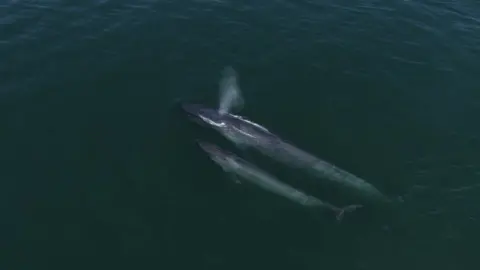 Oceanic films
Oceanic filmsBlue whales - the largest animals on Earth - are making their home in a part of the Indian Ocean where they were wiped out by whaling decades ago.
Researchers and filmmakers in the Seychelles captured footage of the whales in 2020 and 2021. It features in the Imax film Blue Whales 3D.
But a year of underwater audio recording revealed the animals spend months in the region.
This means they could be breeding there, scientists say.
The researchers, including scientists from the University of Seychelles, described the discovery as a "conservation win" after the Soviet whaling fleet decimated the population in the 1960s.
One of the lead investigators, Dr Kate Stafford, told BBC News: "It turns out if you stop killing animals on mass scales and you give them a chance to rebound, they can recover."
Commercial whaling has had a lasting impact. Blue whale numbers are still a tiny proportion of what they were and the species is listed as endangered by the International Union for the Conservation of Nature.
More than 300,000 were killed in the southern hemisphere alone - chased down by modern, fast whaling ships.
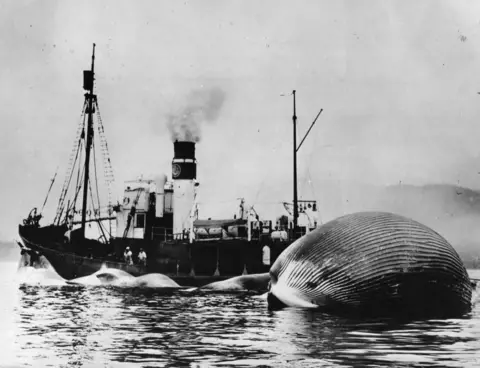 Getty Images
Getty Images"This is the largest animal to ever exist on the planet," Dr Stafford said, adding: "We want to know where they are coming back and knowing there's a population around the Seychelles is incredibly exciting."
The discovery, published in the Journal of Endangered Species Research, was the result of fixing a "sound trap" to the seabed close to the tiny island nation.
Fitted with underwater microphones, batteries and recording devices, the trap was left in place for a year, recording 15 minutes of every hour, every day.
During the team's month-long expedition, Dr Stafford also spent a few hours each day dangling a hydrophone [underwater microphone] into the water.
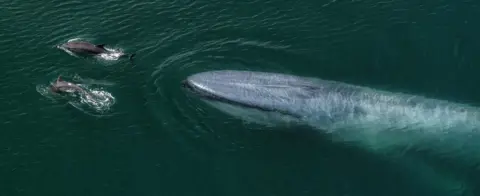 Oceanic Films
Oceanic FilmsChris Watson, the wildlife sound recordist on the trip, told BBC News: "We heard remarkable things - the tapping of sperm whales thousands of feet down and dolphins echolocating and communicating but sadly no blue whales."
However, after scientists retrieved their sound trap, painstaking analysis of the recording revealed blue whales were there and communicating when the researchers were not.
The mammals' signature, very low frequency song could be heard primarily during March and April.
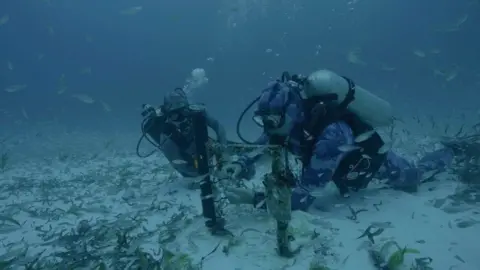 Oceanic films
Oceanic films"This means the Seychelles could be really important for blue whales," said Dr Stafford, explaining: "They sing during the breeding season and we think it's probably the males who are singing, based on what we know about other whales.
"So there's also potential that the Seychelles is a breeding area or a nursery area."
The scientists were even able to pick out which acoustic population the blue whales in the area belong to.
Dr Stafford said: "You can tell them apart by the sounds they make. In the Seychelles we heard one acoustic population - the one generally associated with the northern Indian Ocean."
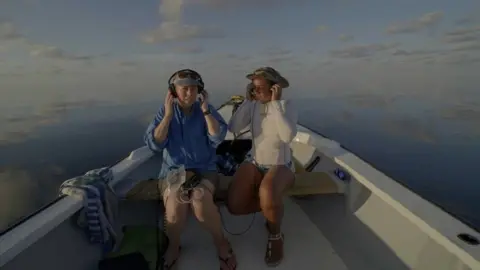 Oceanic Films
Oceanic FilmsThe song or fundamental frequency of the blue whale is so deep and such a low frequency that it is beyond the range of human hearing.
But Mr Watson, who has managed to record blue whales in the Sea of Cortez, said we can hear what are called its harmonics - higher frequency sounds that "ring out" when a blue whale sings, explaining: "It's this really low, deep, consistent pulse.
"When I recorded blue whales in Mexico, that was what was resonating in my headphones."
Dr Stafford added: "It's the loudest sustained sound in the animal kingdom. [Their call lasts] 15 to 20 seconds at about 188 decibels, which is the equivalent of a jet engine in air."
Sound travels much faster and further in water, enabling blue whales to communicate over distances of hundreds and even thousands of miles.
A quiet haven
Conservation scientists are keen to understand exactly how important the Seychelles is for blue whales.
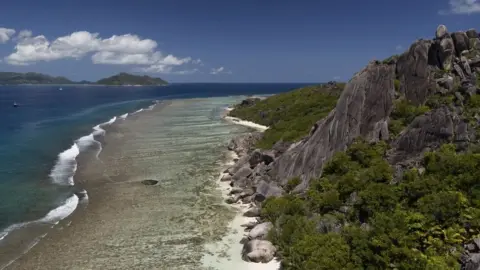 Oceanic FIlms
Oceanic FIlmsAn area around the islands has been formally protected in a unique "debt for nature" swap, where the country had almost £16.8m ($22m) of its national debt written off in exchange for doing more to protect its oceans.
About 400,000 square kilometres (154,000 square miles) of its seas are now protected.
Dr Jeremy Kiszka from Florida International University, a lead scientist on the study, told BBC News that the diversity and abundance of marine mammals in the region was "exceptional". "We recorded 23 species during our surveys," he said.
"Some of these are among the least known species of whales and dolphins around the world. We now need to understand why and make sure human activities do not affect blue whales and other species present."
One major concern is protecting important areas for blue whales from noise pollution, which travels equally efficiently through the water.
"There's not a tremendous amount of ship traffic in the Seychelles so perhaps we could think of it as a nice, quiet, safe place for blue whales," said Dr Stafford.
